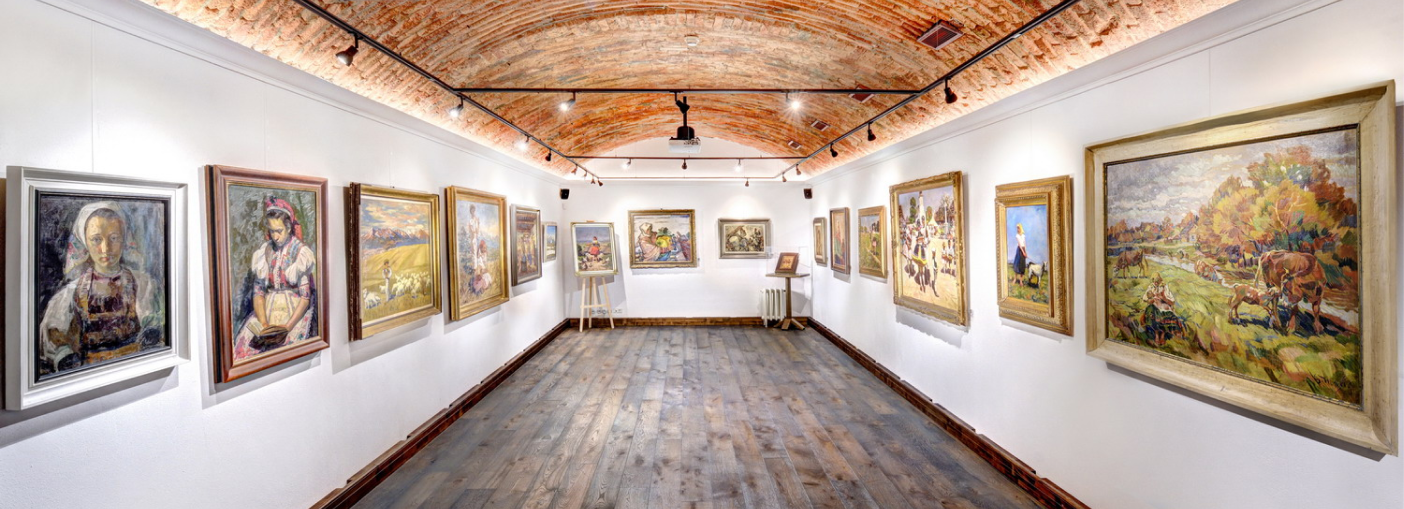
Martin Benka was born in 1888, in Kostolište and died in 1971 in Malacky. He was trained as an interior painter in Hodonín (1903 – 1906) and in 1906 – 1909, he worked as a painter trainee in Vienna, where he started to attend the private atelier of E. Neumann in 1908. Support from the writer J. Langner enabled Benka to study in the private school of landscape painting of Alois Kalvoda in Prague (in 1909 – 1913). In 1913, he visits Upper Hungary for the first time, especially the region of Orava (the village of Veličná). In 1910 – 1914, he went together with other painters form the Kalvoda’s school several studying trips to surroundings of the Křivoklát castle and Moravské Slovácko region. In 1914, he obtained his first atelier in Prague, and in 1915 – 1918, he lived and worked in Miloňovice, in the Šumava mountains. His first individual exhibition dates back to 1915 in Rohatec; his first Slovak exhibition was organised in 1920 within the Society of Slovak Artists. He settled in Prague in 1918, where he lived until 1939. Between 1924 he 1936 went on numerous studying journeys (Italy, Germany, The Netherlands, Belgium, France, Morocco, Soviet Union). His works were featured at the Venice Biennale several times (1926, 1934, 1942, 1954). He also participated in the Paris World Expo in 1937, where he was awarded the silver medal for his painting titled Landscape near Terchová. In 1939 he settled in Martin and in 1940 – 1941 he led a Department of Painting and Drawing as an external professor at the Slovak University of Technology in Bratislava. In 1958 he moved to the atelier house with picture gallery in the town of Martin, which was built by the government. In a trade-off deal, Benka donated to the government in 1964 over 5000 of his works, which became the core of the museum funds of the Martin Benka Museum in Martin (part of the Slovak National Museum). The memorial room dedicated to the painter was made accessible in his native village of Kostolište. Martin Benka was a founding member and the Chairman of the Society of Slovak Artists and the Arts Department of Matica Slovenská in Martin. He was given numerous awards both at home and abroad and was awarded with the Order of the Republic and as the very first graphic artist, he obtained the title of National Artist. Besides painting, Benka was also active in graphics, applied art, drawing and illustration. Early work of Martin Benka was influenced by the tuition and leadership of Alois Kalvoda. However, around 1913, Benka attempted to dramatically re-consider this impressionist approach with a secessionist stylisation of drawing, release of the colourful stain and decorative feel for the composition. The most important change in Benka’s work took place around 1920 and followed for the next 2 decades, when Benka formulated his monumentalist, heroizing and romantic-patriotic program of mountain iconography. Initially, this program had no alternative in Slovak modern painting, only towards the end of the 1920s, Alexy and Bazovský attempted to come up with one by declaring greater simplification and suppression of the ethnographic attributes. However, the small-size compositions of Martin Benka remain the most impressive. These are the paintings, where he does not push through the monumentalist pathos but gives more space to spontaneity of drawing, natural colours and loose diction of the paintbrush with admirable graphical shortcuts. Similar qualities can be found in Benka’s consistent drawing and illustration resourcefulness as well as his illustrating activity. Source: Cincík, J.: Martin Benka. Bratislava 1935; Váross, M.: Martin Benka. Bratislava 1952; Váross, M.: Martin Benka. Výber z olejomalieb. Bratislava 1955; Petránsky, Ľ.: Martin Benka. Bratislava 1977; Zborník Martin Benka a slovenská kultúra. Bratislava 1978; Chmelová, E.: Martin Benka, Príbeh maliarovho života. Bratislava, 1980; Váross, M.: Martin Benka. Bratislava 1981; Baranovič, Š. – Zaťková, Ľ.: Martin Benka – sprievodca po živote a diele. Martin 1988; Bajcurová, K.: Martin Benka. Trenčín 2005.
